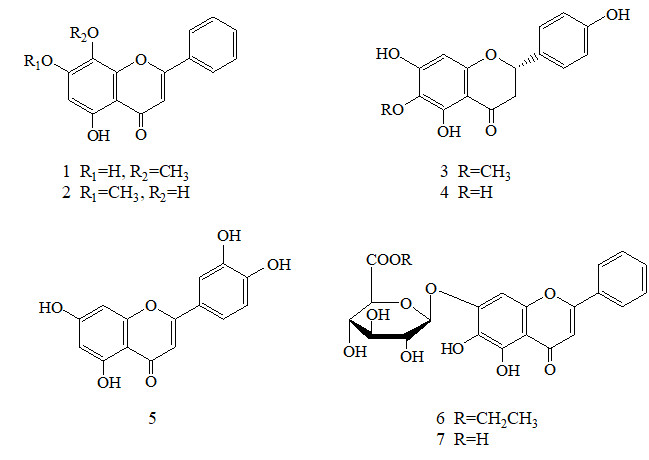INVESTIGATION OF FLAVONOIDS OF THE ROOT OF THE PLANT SCUTELLARIA INTERMEDIA POPOV
Abstract
Plants of the genus Scutellaria L. – the skullcap (the Lamiaceae family) on the globe are represented by 360 species, widespread in temperate, subtropical and tropical regions, including Europe, North America and East Asia. They are used in folk medicine and are a source of unique biologically active compounds with valuable pharmacological properties. The article is devoted to the phytochemical study of the flavonoids of the roots of S. intermedia. From the ethyl acetate and n-butanol fractions of the 80% ethanol extract of the roots, 6 flavonoids were first isolated. Based on the results of chemical transformations, UV, 1H, 13C NMR and mass spectra, comparison of physicochemical constants with literature data, and comparison with samples of flavonoids isolated from other species of Scutellaria L., the compounds obtained wogonine, 5,8-dihydroxy-7-methoxyflavone, 5,7,4'-trihydroxy-6-methoxyflavanone (dihydrohispidulin) 5,6,7,4'-tetrahydro- xiflavane (dihydroscutellarein), luteoline and baicalein 7-O-β-D-ethyl glucuronide.
Downloads
Metrics
References
Юзепчук С. В. Шлемник - Scutellaria L., в кн.: Флора СССР. М.-Л.: Изд-во АН СССР. 1954. Т. XX. С. 72-225.
Растительные ресурсы СССР. Цветковые растения, их химический состав, использование. Семейства Hippuridaceae-Lobeliacae. СПб., 1991. C.85-90.
Shang X., He X., He X., Li M., Zhang R., Fan P., Zhang Q., Jia Z. The genus Scutellaria an ethnopharmacological and phytochemical review. //J. Ethnopharmacol. 2010. V.128. P.279-313.
Маликов В.М, Юлдашев М.П. Фенольные соединения растений рода Scutellaria L.: распространение, строение и свойства. //Химия природ. соедин. 2002. №4. С. 299-324; 2002. №5. С.385-407.
А.М. Каримов, Э.Х. Ботиров, А.У. Маматханов, Ш.Ш. Сагдуллаев. Флавоноиды растений рода Scutellaria L. -Ташкент: “Fan va texnologiya”, 2016, 180 с.
Каримов А.М., Ботиров Э.Х. Структурное разнообразие и степень изученности флавоноидов рода Scutellaria L. //Химия растительного сырья. 2016. №1. С. 5–28.
Li-Weber M. New therapeutic aspects of flavones: the anticancer properties of Scutellaria and its main active constituents wogonin, baicalein and baicalin //Cancer Treat. Rev. 2009. V.35. Р.57-68.
Yu, J.Q., Liu, H.B., Lei, J.C., Tan, W.J., Hu, X.M., Zou, G.L. Antitumor activity of chloroform fraction of Scutellaria barbata and its active constituents. //Phytotherapy Research 2007. V. 21. P. 817–822.
Sonoda M., Nishiyama T., Matsukawa Y., Moriyasu M. Cytotoxic activities of flavonoids from two Scutellaria plants in Chinese medicine // J. Ethnopharmacol. 2004. V. 91. P. 65–68
Gao, Z., Huang, K., Yang, X., Xu, H. Free radical scavenging and antioxidant activities of flavonoids extracted from the radix of Scutellaria baicalensis Georgi. //Biochim. Biophys. Acta. 1999. V.1472. №3. Р.643-650.
Park, H.G., Yoon, S.Y., Choi, J.Y., Lee, G.S., Choi, J.H., Shin, C.Y., Son, K.H., Lee, Y.S., Kim, W.K., Ryu, J.H., Ko, K.H., Cheong, J.H. Anticonvulsant effect of wogonin isolated from Scutellaria baicalensis. //European J. Pharmacology. 2007. V. 574. P. 112–119.
Минаева В.Г. Шлемник байкальский Scutellaria baicalensis Georgi. Лекарственные растения Сибири. Новосибирск: Наука. Сиб. отд-ние. 1991. С.212-214.
Karimov A. M., Botirov E. Kh. 7-O-Glucosides of Norwogonin and Isoscutellarein from the Aerial Part of Scutellaria adenostegia. // Chem. Natur. Compounds. 2016. V. 52. № 5. С.907-908.
Karimov A. M., Slobodyanyuk T. N., Botirov E. Kh. Flavonoids from the aerial part of Scutellaria intermedia. //Chem. Natur. Compounds. 2017. V. 53. № 4. P. 745-746.
Karimov A. M., Slobodyanyuk T. N., Botirov E. Kh. New flavonoid glicuronides from the aerial part of Scutellaria intermedia. //Chem. Natur. Compounds. 2017. V. 53. № 4. P. 638-641.
Karimov A. M., Botirov E. Kh. Flavonoids from the aerial part and roots of Scutellaria adenostegia// Chem. Natur. Compounds. 2015. V. 51. № 4. С.764-765.
Хушбактова З.А., Файзиева С.Х., Сыров В.Н., Юлдашев М.П., Батиров Э.Х., Маматханов А.У. Выделение, химический состав и гиполипидемическая активность суммы флавоноидов из Thermopsis alterniflora //Хим. – фарм. журнал. – 2001. – Т. 35, №3.– С 35-38.
Yuldashev M. P., Batirov E. Kh., Malikov V. M. Flavonoids of the epigeal part of Scutellaria ramosissima. // Chem. Natur. Compounds. 1992. V. 28. P. 151-154.
Wang M-H, Li L-Z, Sun J-B, Wu F-H, Liang J-Y. A new antioxidant flavone glycoside from Scutellaria baicalensis Georgi. Natural Product Research. 2014. V. 28, № 20. P. 1772-1776.
D.M. Delange, C. L. Morales Rico,V. G. Canavaciolo, A. C. Cuellar, E. S. Oliver. Selective and High Yield Isolation of Pure Wogonin from Aerial Parts of Scutellaria havanensis Jacq. Int. J. Pharm. Sci. Rev. Res., 2015; 30 (2), P. 104-108
T. Nikaido, T. Ohmoto, T. Kinoshita, U. Sankawa, F.D. Monache, B. Botta, T. Tomimori, Y. Miyaichi, Y. Shirataki, I. Yokoe, M. Komatsu, Inhibition of Adenosine 3', 5'-Cyclic Monophosphate Phosphodiesterase by Flavonoids. III Chem. Pharm. Bull. 37, 1392–1395 (1989)
Н.В. Попова, Н.Ф. Маслова, С.И. Дихтярев, В.И. Литвиненко, Лекарственные свойства лютеолина. Противовоспалительные и противоаллергические свойства Фітотерапія. Часопис № 3, 2010 С.43-48.


This work is licensed under a Creative Commons Attribution 4.0 International License.
The authors, which are published in this journal, agree to the following conditions:
1. Authors retain the copyright to the work and transfer to the journal the right of the first publication along with the work, at the same time licensing it under the terms of the Creative Commons Attribution License, which allows others to distribute this work with the obligatory indication of the authorship of this work and a link to the original publication in this journal .
2. The authors retain the right to enter into separate, additional contractual agreements for the non-exclusive distribution of the version of the work published by this journal (for example, to place it in the university depository or to publish it in a book), with reference to the original publication in this journal.
3. Authors are allowed to post their work on the Internet (for example, in a university repository or on their personal website) before and during the review process of this journal, as this may lead to a productive discussion, as well as more links to this published work.











